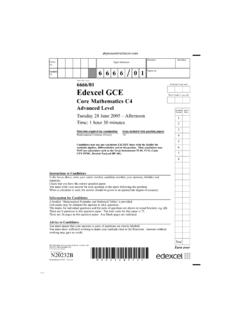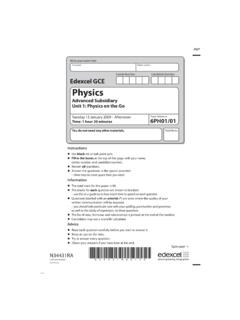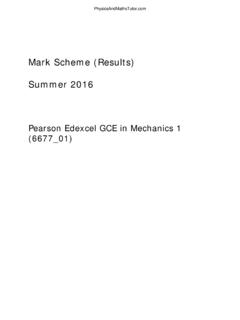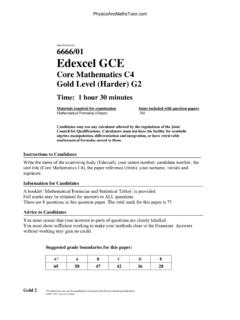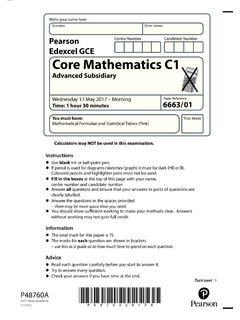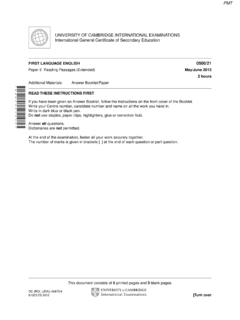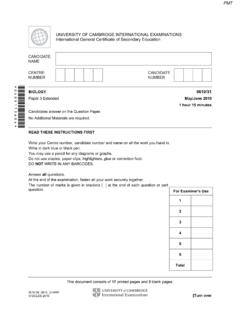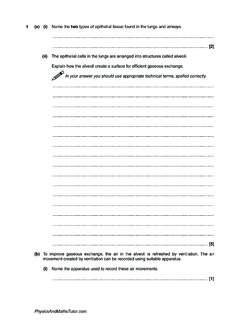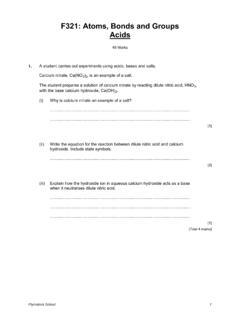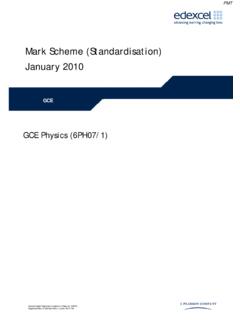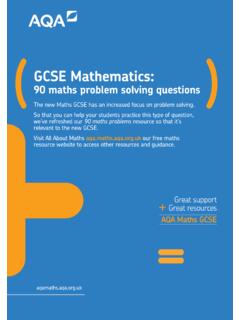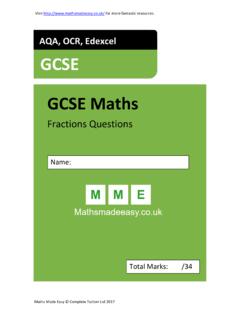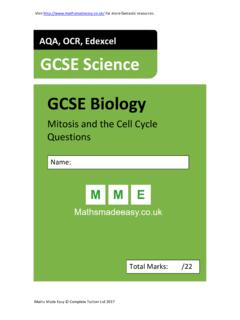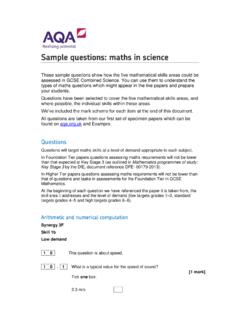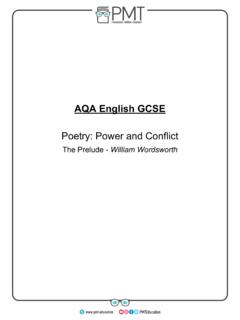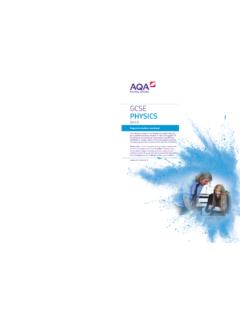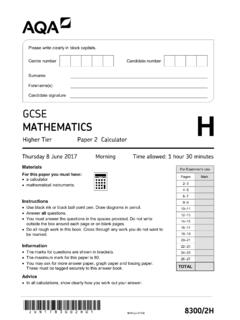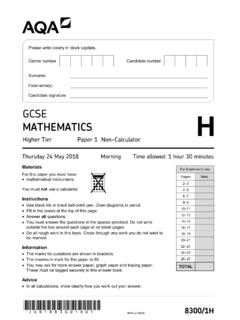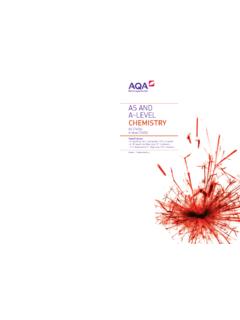Transcription of AQA English GCSE Poetry: Power and Conflict
1 AQA English gcse Poetry: Power and Conflict Bayonet Charge - Ted Hughes work by PMT Education is licensed under CC BY-NC-ND BAYONET CHARGE Ted Hughes Brief Summary Hughes depicts a soldier for a few seconds, desperately charging into battle. Synopsis A soldier is thrown into a battle completely unprepared He is clumsy and confused He pauses on the battlefield to consider his role in war A hare gets thrown in front of him from the fighting The hare is dying and suffering in front of him which jolts him back to consciousness He realises the danger he is in Reverts to his instincts and runs towards the battle in fear Context Ted Hughes (1930-1998) Ted Hughes was a famous war poet.
2 However, as he wasn t alive during WW1 and was a child during WW2, he never fought or saw war firsthand. Instead, Hughes grew up in the post-war era and saw its influence in his home in Yorkshire. This rural upbringing is evident in his poetry which usually focuses on animals. Hughes studied mythology which is shown in the image of the yellow hare as well as anthropology which is shown through the poem s fixation on instinctual behaviour. The poem is from the collection The Hawk in the Rain which was dedicated to his wife, Sylvia Plath. The poems in the collection were focused on the real and symbolic lives of animals. Bayonet Charge Hughes was writing in a post-war era that was greatly influenced by WW1 and WW2.
3 The poem was published in 1957 but was set in WW1. His poems are a way for him to make sense of the events he never saw but whose impacts were seen daily Hughes father fought in WW1 and was one of only seventeen Lancaster Fusiliers to survive the Gallipoli campaign, leaving him emotionally traumatised for life. It is thought that in Bayonet Charge Hughes wanted to highlight the brutality of trench warfare as a tribute to his father s suffering as well as a way to memorialize war as a warning for future generations. This poem was greatly inspired by Wilfred Owen who similarly tries to depict the reality of war in his poetry. Owen also wrote about events that he had never experienced, showing his insight.
4 Bayonet Charge This thrusts the listener into the action and relates to the idea of waking up. This metaphor shows the physical impact of the soldier s fear. Suddenly he awoke and was running raw In raw -seamed hot khaki, his sweat heavy , Stumbling across a field of clods towards a green hedge That dazzled with rifle fire , hearing Bullets smacking the belly out of the air He lugged a rifle numb as a smashed arm; The patriotic tear that had brimmed in his eye Sweating like molten iron from the centre of his chest, In bewilderment then he almost stopped In what cold clockwork of the stars and the nations Was he the hand pointing that second? He was running Like a man who has jumped up in the dark and runs Listening between his footfalls for the reason Of his still running, and his foot hung like Statuary in mid-stride.
5 Then the shot-slashed furrows Threw up a yellow hare that rolled like a flame And crawled in a threshing circle, its mouth wide Open silent, its eyes standing out. He plunged past with his bayonet toward the green hedge, King, honour, human dignity, etcetera Dropped like luxuries in a yelling alarm To get out of that blue crackling air His terror s touchy dynamite. The use of repetition creates a sense of desperation. The connotations of raw are animalistic which denotes a lack of humanity in the situation. A clod is a mound of earth. The sparks created by rifle fire are beautified in this image. Fear appears to have taken over the soldier s patriotism. Mechanical imagery is emphasised by the harsh alliteration and implies that the soldier has been dehumanised in his role.
6 Rural imagery is subverted to create a juxtaposition between the nourishing connotations of farming and the life being taken away in the same place. It appears that the hare is screaming. This metaphor creates a tense, violent atmosphere and also alludes to someone being winded and unable to breathe. The use of the hyphen creates a pause which coincides with the idea of the soldier being about to stop. The soldier begins to further question the reason for him fighting. The violent connotations of Threw up contrast with the innocence connotated by a hare. The soldier appears to have completely abandoned his previously upheld values and motivation to fight.
7 Perspective The poem is written in the third person singular which gives a limited narrative perspective . This allows the reader to focus on the individual impact of war by showing the way war impacts a single individual. As it s written from a soldier s perspective, the reality of the war experience is horrific to the reader who finds it impossible to view war favourably. Even though the war may be beneficial nationally, and serving in a war is seen as honourable, the poem shows that this does not excuse the suffering it inflicts on individual soldiers . This third person singular perspective also emphasises the isolation felt by soldiers in war. As the protagonist is the only human in the poem, he is isolated from any source of help or comfort.
8 The isolation helps to intensify the suffering of the speaker and focuses the audience on the impact that war has on them. This shows that despite fighting in an army a battle is about self-preservation and that they are ultimately on their own. Moreover, soldiers are still neglected by the nation they fought for and are left to go back to society. The poem is highly focused on one soldier s emotions which is ironic as soldiers were expected to show no emotion and also shows how the soldier referenced cannot share his feelings with his peers. Hughes depicts a soldier desensitised to the harshness of war, he appears immune to the death of other soldiers and it takes the suffering of nature to break his trance-like state.
9 Structure Hughes employs a chaotic structure in his poem to mirror the chaos and panic of war . Enjambment Enjambment stops the reader from taking a break or pause which quickens the pace of the poem. The whole of the first stanza is a single sentence . This matches the tense action of the poem and maintains the momentum of a bayonet charge and helps the readers to empathise with the panic and fear felt by the soldier. The enjambment helps to emphasise the importance of the rhetorical question it ends on was he the hand pointing that second? . Here, the reader is forced to question whether the soldier is at war by his own choice or is a mechanical cog in a constantly ticking clock.
10 Caesura The fast pace created by the enjambment in the first stanza starkly contrasts with the second stanza. The pace of the second stanza is much slower as it s broken up with lots of caesura . Here the soldier stops to consider the philosophical meaning of war. The pace of the poem is paused, implying that time has stopped or the soldier is so overwhelmed that they are forced to pause and consider. This has the alternative effect of causing the listener to pause and consider the reality of war. Hughes frequent use of enjambment and caesura makes the poem feel disjointed and confusing. The structure is consistent with his message that war cannot be understood fully (it is confusing to the reader also to the soldier).
